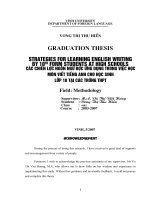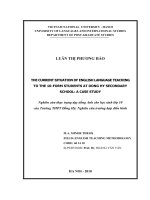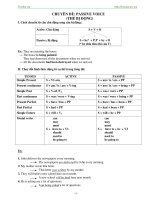BÀI TẬP TIẾNG ANH CHO HỌC SINH 10 TĐ
Bạn đang xem bản rút gọn của tài liệu. Xem và tải ngay bản đầy đủ của tài liệu tại đây (89.75 KB, 2 trang )
<span class='text_page_counter'>(1)</span><div class='page_container' data-page=1>
<b>UNIT 7-CULTURAL DIVERSITY</b>
<b>PRACTICE TEST 2</b>
<b>1.A. scatter</b> <b>B. value</b> <b>C. adult</b> <b>D. vary</b>
<b>2.A. chocolate</b> <b>B. characteristic</b> <b>C. children</b> <b>D. change</b>
3.A. image B. immigrate C. imitate D. import
4.A. confident B. concent C.contrast D. constant
5. It is a ... belief that broken mirrors will bring bad luck.
A. usual B. normal C. similar D. common
6
. Thank you. That was ... very nice lunch
A. a B. an C. the D.
7. Get off the bus ... it stops
A. so quick as B. so fast as C. so soon as D. as soon as
8. I never listen to ... radio . In fact I haven’t got ... radio.
A. a / a B. a / the C. the / the D. the / a
9. What is the similarity between Vietnamese culture and Thai culture ?
A. That sounds interesting B. I couldn’t agree more. I like Vietnamese culture and Thai culture
C. That’s true. They don’t know much about this D. I think it is food
10. Mount Everest is ... mountain on the earth.
A. the tallest B. the taller C. tall D. tallest
11. My closest friend is looking forward to receiving a scholarship to study at a university in ... Italy
A. a B. an C. the D.
12. Today’s top sports people receive a lot ... money than in the past.
A. much B. many C. more D. most
13. Our atmosphere is gradually becoming more and ... polluted
A. much B. many C. more D. most
14. Many old people don’t like change. They are very set in their ...
A. life B. habits C. routines D. ways
15. I’m afraid we can’t raise your ... this year. The company’s operating on a very tight budget.
A. salary B. promotion C. job D. equality
16. are surprisingly widespread, including a fear of Friday the 13th and a belief in good-luck charms
A. Superstitions B. Superstitious C. Traditions D. Custom
17. People aren’t working because it is a holiday. The children ... go to school either.
A. don’t have to B. mustn’t C. don’t D. haven’t to
18 .One of the more beautiful botanical gardens in the US is the wild and lovely Magnolia Garden
A B C D
<b>Choose the word or phrase ( A, B , C or D) that best fits each space in the following passage.</b>
<b> As our world shrinks everyday and people are travelling all over the world, we are all being exposed to more</b>
varieties fro cultures. But we don’t always have to (19) ... home to meet people from all over the world. Just
look in the backyard of your own hometown, city and state. We are all now more a (20) ... of a truly global
culture than ever before. We are now meeting, dating, falling in love and marrying people of many different cultural and
religious (21) ... than oue town.
Your wedding will be special no matter what traditions you follow, as long as you have someone special
( 22) ... your side. Wedding are as individual in style as they are universal as a ritual. Weddings are a time of
family and friends, and traditions; family heritage (23) ... to incorporate culture items in the theme of your
wedding. Traditions can be small subtle things that (24) ...the couple’s faimlies’ heritages. Or you can make
your cultural or religious traditions the rmain theme for your wedding. Cultural (25) ... is one way to personalize
your wedding. Or you can have special segments to promote our and or your fiance’s heritage. It is a nice and easy way
to incorporate personal pride in your ancestry, especially today when more couples are multiculture ones. Each and evey
culture is rich in wedding customs and traditions. Spice up your special day with a salute to your heritage. Or you can
start your own traditions or borrow from another culture’s customs and traditions. Then some couples will have a
traditional Western ceremony and then do a special ceremony from their own like a Korean tea ceremony.
19.A. leave B. move C. change D. build
20.A. role B. part C. lot D. number
21.A. knowledge B. expertise C. qualifications D. backgrounds
22.A. near B. close C. by D. with
23.A. is B. being C. uses D. using
</div>
<span class='text_page_counter'>(2)</span><div class='page_container' data-page=2>
25.A. variety B. wealth C. diversity D. abundance
<b>Choose the word or phrase ( A, B , C or D) that best fits each space in the following passage.</b>
One custom that gives insight into people’s history and values is the way they greet one another. There is a wide
range of greetings around the world. These range from the common handshake to other strange rituals found in some
countries. Let’s take a look at how the simple action of greeting someone differs greatly from place to place.
In the United States and Canada, for example, a simple handshake or nod is the norm. The handshake has an
interesting origin: it started long ago as a way of showing people that you weren’t carrying a weapon. Shaking the
person’s right hand while looking him or her in the eye is the usual method. Handshakes are also common in other parts
of the world, including Britain and Russia. In Russia, males grasp other men’s hands very strongly during the
handshake. Handshakes are also how most people in New Zealand greet each other. However, the native Maori people
of that country display more physical contact: they press their noses together in a sign of trust and closeness.
In other countries, such as France and Belgium, hugging and kissing are more common when two people meet. In
those cultures, people kiss each other on the cheeks. The number of times varies depending on the particular country. In
Saudi Arabia, men might hug and kiss each other (but not a woman) on the cheek. Men will also shake hands with other
men there. In some Eastern countries, including Korea and Japan, bowing is the traditional greeting. In Japan, the
deeper the bow, the deeper the respect shown. The strangest custom, though, is likely in Tibet. People there opt to stick
out their tongue to greet others.
<i>26. What is this reading mainly about ? </i>
A. The importance of handshakes all around the world B. The origins and histories of various greetings
C. The strangest types of greetings on Earth. D. The wide range of greeting customs in the world
<i>27. Which of the following sentence is TRUE ?</i>
A. People in Russia, but not England, shake hands B. The number of times people kiss on the cheek varies
C. In the past, people nodded If they weren’t carrying a
weapon
D. You shouldn’t look at people when shaking their
hands in the United States
<i> 28. How do most people in New Zealand greet each other</i>
? - ...
A. With a handshake B. By pressing noses together
C. With a kiss on the cheek D. By sticking cut their tongue
<i>29. Which type of country is NOT mentioned in the reading ?</i>
A. A North American country B. A European country
C. A South American country D. An Asean country
<i>30. What can be inferred about getting customs in Saudi Arabia ?</i>
A. Men shake hands with women when meeting them for the first time
B. It’s not proper for men to kiss women when they meet
C. Women do not kiss other women when they meet
</div>
<!--links-->









